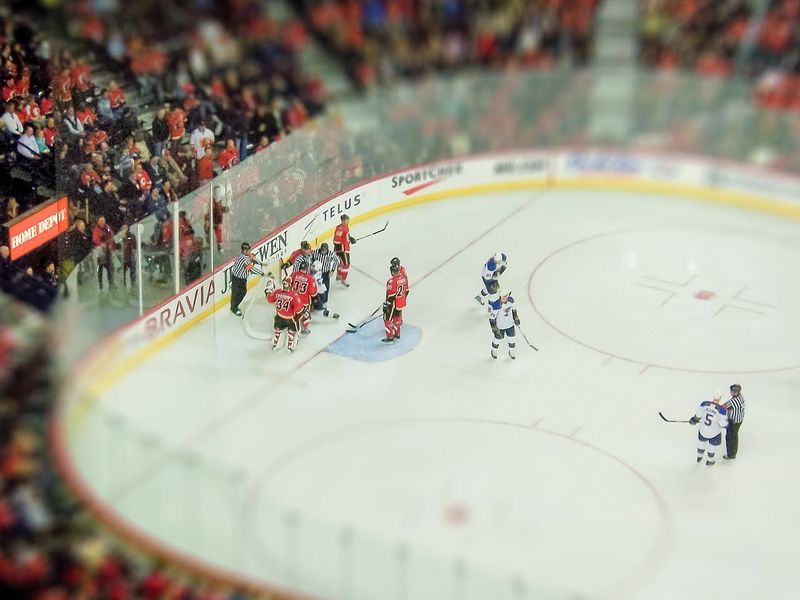Yes, it’s usually cold inside hockey games. The ice must stay frozen, so arenas keep temperatures low.
Hockey games are thrilling events, but many wonder about the cold inside arenas. The chill helps maintain the ice surface, crucial for the game. Spectators often experience cooler temperatures than they might expect. This guide explores why hockey arenas are cold and what to expect.
We’ll also discuss how to stay comfortable during a game. Understanding the environment can enhance your experience. So, let’s dive into why hockey games are a bit chilly and what you can do about it.
Temperature Inside Hockey Arenas
Hockey arenas are known for their chilly atmosphere. Many wonder just how cold it is inside. The temperature plays a crucial role not only for the players but also for the spectators. Let’s dive deeper into the specifics.
Optimal Ice Conditions
Maintaining the right temperature is vital for optimal ice conditions. The ice needs to be hard and smooth for the game to be played well. Typically, the ice surface is kept at about 24°F (-4°C). This temperature ensures that the ice remains solid and doesn’t melt or become too brittle.
| Ice Surface Temperature | Ideal Range |
|---|---|
| 24°F | -4°C |
Spectator Comfort
While the ice must be cold, spectator comfort is also important. The air temperature in the arena is usually kept between 50°F and 60°F (10°C to 15°C). This balance allows the ice to stay frozen while keeping the audience comfortable. Fans often wear warm clothing to stay cozy during the game.
- Wear layers.
- Bring a blanket.
- Stay active to keep warm.
Being prepared can make the experience more enjoyable. Knowing the temperature can help you dress appropriately. So next time you visit a hockey game, remember to bundle up!

Credit: www.tiktok.com
Factors Affecting Arena Temperature
When attending a hockey game, you might wonder, “Is it cold inside hockey games?”. The temperature inside an arena can vary based on several factors. Understanding these factors can help you prepare for your visit. Let’s explore the key elements that influence the temperature in a hockey arena.
Ice Maintenance
Maintaining the ice quality is crucial for a good hockey game. The ice needs to stay frozen to ensure smooth gameplay. To achieve this, the arena temperature is often kept low. This helps prevent the ice from melting and keeps it at the right consistency.
Ice rinks use refrigeration systems to keep the ice frozen. These systems work best in a cool environment. As a result, the air temperature in the arena is often set between 50°F and 60°F. This helps maintain the ice while keeping it comfortable for the players.
Crowd Size
The size of the crowd can also affect the arena temperature. More people in the arena generate more body heat. This can raise the overall temperature inside the venue.
During a sold-out game, the arena might feel warmer. Yet, the refrigeration systems still work to keep the ice cold. The combination of body heat and the cooling system helps balance the temperature. On less crowded days, you might notice the arena feels colder.
Here’s a quick summary of how crowd size impacts arena temperature:
| Crowd Size | Temperature Effect |
|---|---|
| Large Crowd | Warmer |
| Small Crowd | Colder |
By understanding these factors, you can better prepare for your next hockey game. Dress in layers to stay comfortable no matter the crowd size or ice maintenance efforts.
Dress Code For Spectators
Watching a hockey game can be thrilling. But the arena can get quite chilly. Spectators need to dress warmly to enjoy the game comfortably. Here, we will discuss the best dress code for spectators.
Layering Up
Layering is key to staying warm during hockey games. Start with a thermal base layer. This traps heat close to your body. Add a sweater or hoodie on top. Finish with a thick jacket or coat.
Wearing multiple layers helps you adjust your warmth. If you get too hot, you can easily remove a layer. This is much better than wearing one heavy item.
Essential Accessories
Do not forget essential accessories. A warm hat is crucial. It keeps your head warm, preventing heat loss. Gloves or mittens are also important. Your hands can get very cold, even indoors.
Scarves provide extra warmth around your neck. Thick socks and insulated boots will keep your feet cozy. Avoid wearing just regular shoes. Remember, comfortable and warm feet make a big difference.

Credit: globalnews.ca
Player Experience On Ice
Hockey players face unique challenges on the ice. The cold environment impacts their performance. They must stay warm and agile. This requires specific routines and gear. Let’s explore the player experience on ice.
Warm-up Routines
Before hitting the ice, players follow strict warm-up routines. These routines help them prepare their bodies for the cold. Stretching, jogging, and light exercises increase blood flow. This ensures they stay flexible and avoid injuries.
Some players use dynamic stretches. This involves moving parts of the body to warm up muscles. It helps them stay loose and ready for action. A proper warm-up is crucial for peak performance.
Protective Gear
Protective gear is essential for hockey players. It keeps them safe from injury and cold. Helmets, gloves, and pads offer protection and insulation. These items are designed to keep players warm.
Skates also play a role in warmth. They provide stability and support. Properly fitted skates prevent cold feet. Wearing layers under uniforms helps trap heat. This ensures players maintain body temperature on the ice.
Technological Innovations
Technological Innovations have dramatically improved the experience inside hockey arenas. Keeping fans comfortable while maintaining the ice quality is crucial. Modern technologies play a significant role in achieving this balance.
Climate Control Systems
Climate control systems in hockey arenas are sophisticated. These systems manage the temperature and humidity levels. They ensure the ice remains solid while fans stay warm. The systems adjust in real-time. This maintains optimal conditions throughout the game.
Many arenas use a combination of HVAC units and dehumidifiers. These units work together to control the climate. The main goals are to prevent the ice from melting and to keep fans from feeling too cold. Below is a table showing the components and their functions:
| Component | Function |
|---|---|
| HVAC Units | Regulate air temperature |
| Dehumidifiers | Control moisture levels |
Advanced Insulation
Advanced insulation is another key factor. Modern arenas use high-tech materials. These materials insulate the building effectively. They help to keep the cold air in and the warm air out.
Insulation not only maintains the ice quality but also keeps energy costs low. The use of reflective barriers and insulating panels has become common. They provide a thermal break, reducing heat transfer. This means the temperature inside remains stable.
Overall, these technological innovations enhance the experience for players and fans. They ensure everyone enjoys the game in comfort.

Credit: www.sportsgearswag.com
Frequently Asked Questions
Is It Cold Inside Hockey Games?
Yes, it is cold inside hockey arenas. The ice needs to stay frozen.
How Cold Is It Inside A Hockey Arena?
Temperature inside is usually between 50-60°F (10-15°C). Dress warmly.
What Should I Wear To A Hockey Game?
Wear layers, a warm jacket, hat, and gloves. Stay cozy.
Do Hockey Players Feel Cold On The Ice?
No, players stay warm by moving a lot during the game.
Can Kids Get Too Cold At A Hockey Game?
Dress them warmly. Layers, hats, gloves, and warm boots help.
Why Do Hockey Arenas Need To Be Cold?
The cold air keeps the ice solid and smooth for play.
Do All Seats In A Hockey Arena Feel Equally Cold?
Seats closer to the ice feel colder. Higher seats are warmer.
Can I Bring A Blanket To A Hockey Game?
Yes, bringing a blanket can help keep you warm and comfortable.
Do Indoor Hockey Games Feel Colder Than Outdoor Games?
Yes, indoor arenas maintain a consistent cold temperature for the ice.
Conclusion
Attending a hockey game can be chilly. Dress warmly to stay comfortable. Layers work best. Bring gloves, hats, and scarves. Enjoy the excitement on the ice. Now you know what to expect. Prepare and have a great time. Hockey games are thrilling and fun.
Stay warm and cheer loud!




